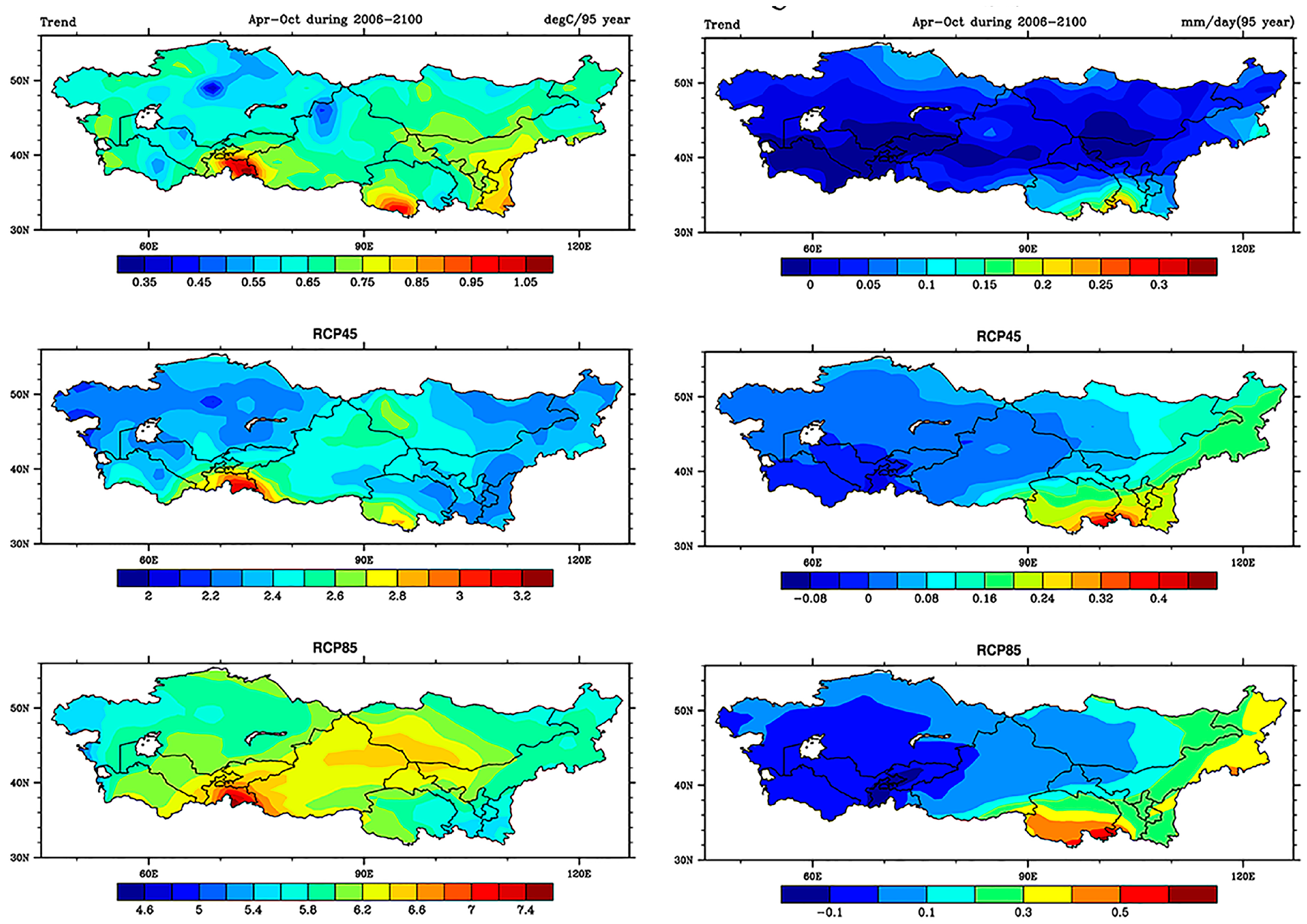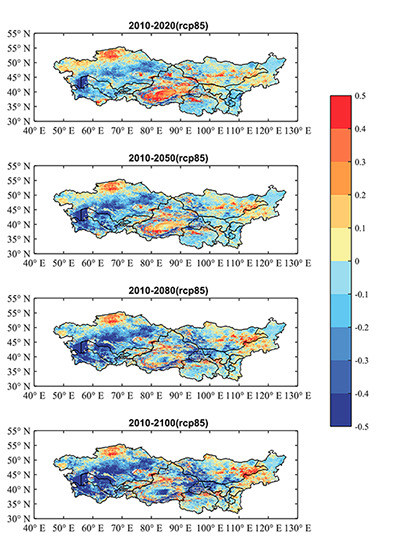Future Climate Impact on the Desertification in the Dry Land Asia Using AVHRR GIMMS NDVI3g Data
Abstract
:1. Introduction
2. Material and Methods
2.1. Study Area
2.2. Datasets
- (1)
- Remote-sensing-based vegetation data
- (2)
- Climate observations and model data

| GCM | Resources | |
|---|---|---|
| 1 | BCC-CSM1-1 | Beijing Climate Center, China |
| 2 | BNU-ESM | Beijing Normal University, China |
| 3 | CanESM2 | Canadian Centre for Climate, Canada |
| 4 | CCSM4 | National Center for Atmospheric Research, USA |
| 5 | CNRM-CM5 | Centre National de Researches Meteorologiques, France |
| 6 | CSIRO-Mk3-6-0 | Commonwealth Scientific and Industrial Research, Australia |
| 7 | FGOALS-g2 | Institute of Atmospheric and Industrial Research, Australia |
| 8 | FIO-ESM | The First Institute of Oceanography, SOA, China |
| 9 | GFDL-CM3 | Geophysical Fluid Dynamics Laboratory, USA |
| 10 | GFDL-ESM2G | Geophysical Fluid Dynamics Laboratory, USA |
| 11 | GFDL-ESM2M | Geophysical Fluid Dynamics Laboratory, USA |
| 12 | GISS-E2-H | NASA Goddard Institute for Space Studies, USA |
| 13 | GISS-E2-R | NASA Goddard Institute for Space Studies, USA |
| 14 | HadGEM2-AO | Met Office Hadley Centre, UK |
| 15 | IPSL-CM5A-LR | Institut Pierre-Simon Laplace, France |
| 16 | IPSL-CM5A-MR | Institut Pierre-Simon Laplace, France |
| 17 | MIROC5 | Atmosphere and Ocean Research Institute, Japan |
| 18 | MIROC-ESM | Japan Agency for Marine-Earth Science and Technology, Japan |
| 19 | MIROC-ESM-CHEM | Japan Agency for Marine-Earth Science and Technology, Japan |
| 20 | MPI-ESM-LR | Max Planck Institute for Meteorology, Germany |
| 21 | MRI-CGCM3 | Meteorological Research Institute, Japan |
| 22 | NorESM1-M | Norwegian Climate Centre, Norway |
2.3. Methods
- (1)
- Multi-model ensemble mean and assessment
- (2)
- Calculation of the relationship between vegetation NDVI and climate change
3. Results
3.1. Multi-Model Ensemble Mean by SMA and BMA

3.2. Temperature and Precipitation Projections from 2006–2100
- (1)
- Temporal trends of the future temperature and precipitation

- (3)
- Spatial trends of future temperature and precipitation

3.3. Relationship between Vegetation Growth and Climate Factors

3.4. Projections of Future Vegetation NDVI Dynamics


4. Discussion
5. Conclusions
Acknowledgments
Author Contributions
Conflicts of Interest
References
- Feng, S.; Fu, Q. Expansion of global drylands under a warming climate. Atmos. Chem. Phys. 2013, 13, 10081–10094. [Google Scholar] [CrossRef]
- Sivakumar, M. Interactions between climate and desertification. Agric. For. Meteorol. 2007, 142, 143–155. [Google Scholar] [CrossRef]
- Mortimore, M.; Anderson, S. Dryland Opportunities: A new Paradigm for People, Ecosystems and Development; IUCN: Gland, Switzerland; IIED: London, UK; UNDP: New York, NY, 2009. [Google Scholar]
- Watts, M. Drought, environment and food security: Some reflections on peasants, pastoralists and commoditization in dryland west Africa. Drought Hunger Afr. 1987, 171–211. [Google Scholar]
- Reynolds, J.F.; Smith, D.M.S.; Lambin, E.F.; Turner, B.L.; Mortimore, M.; Batterbury, S.P.J.; Downing, T.E.; Dowlatabadi, H.; Fernández, R.J.; Herrick, J.E.; et al. Global desertification: Building a science for dryland development. Science 2007, 316, 847–851. [Google Scholar] [CrossRef] [PubMed]
- Lioubimtseva, E.; Henebry, G.M. Climate and environmental change in arid central asia: Impacts, vulnerability, and adaptations. J. Arid Environ. 2009, 73, 963–977. [Google Scholar] [CrossRef]
- Hellden, U. Desertification: Time for an assessment? Ambio 1991, 20, 372–383. [Google Scholar]
- IPCCAR5. In Climate Change 2013: The Physical Science Basis; Cambridge University Press: Cambridge, UK/New York, NY, USA, 2014.
- Thomas, R.J. Opportunities to reduce the vulnerability of dryland farmers in central and west Asia and north Africa to climate change. Agric. Ecosyst. Environ. 2008, 126, 36–45. [Google Scholar] [CrossRef]
- Huang, J.; Guan, X.; Ji, F. Enhanced cold-season warming in semi-arid regions. Atmos. Chem. Phys. 2012, 12, 5391–5398. [Google Scholar] [CrossRef]
- Ci, L.J.; Yang, X.H.; Chen, Z.X. The potential impacts of climate change scenarios on desertification in China. Earth Sci. Front. 2002, 9, 287–294. (In Chinese) [Google Scholar]
- Piao, S.; Nan, H.; Huntingford, C.; Ciais, P.; Friedlingstein, P.; Sitch, S.; Peng, S.; Ahlstrom, A.; Canadell, J.G.; Cong, N.; et al. Evidence for a weakening relationship between interannual temperature variability and northern vegetation activity. Nat. Commun. 2014, 5. [Google Scholar] [CrossRef] [PubMed]
- Miao, L.; Jiang, C.; Xue, B.; Liu, Q.; He, B.; Nath, R.; Cui, X. Vegetation dynamics and factor analysis in arid and semi-arid inner Mongolia. Environ. Earth Sci. 2015, 73, 1–10. [Google Scholar] [CrossRef]
- Zhou, L.; Tucker, C.J.; Kaufmann, R.K.; Slayback, D.; Shabanov, N.V.; Myneni, R.B. Variations in northern vegetation activity inferred from satellite data of vegetation index during 1981 to 1999. J. Geophys. Res.: Atmos. 2001, 106, 20069–20083. [Google Scholar] [CrossRef]
- Miao, L.; Luan, Y.; Luo, X.; Liu, Q.; Moore, J.C.; Nath, R.; He, B.; Zhu, F.; Cui, X. Analysis of the phenology in the mongolian plateau by inter-comparison of global vegetation datasets. Remote Sens. 2013, 5, 5193–5208. [Google Scholar] [CrossRef]
- Lunetta, R.S.; Knight, J.F.; Ediriwickrema, J.; Lyon, J.G.; Worthy, L.D. Land-cover change detection using multi-temporal MODIS NDVI data. Remote Sens. Environ. 2006, 105, 142–154. [Google Scholar] [CrossRef]
- Wang, J.; Dong, J.; Liu, J.; Huang, M.; Li, G.; Running, S.; Smith, W.; Harris, W.; Saigusa, N.; Kondo, H.; et al. Comparison of gross primary productivity derived from gimms NDVI3g, GIMMS, and MODIS in southeast Asia. Remote Sens. 2014, 6, 2108–2133. [Google Scholar] [CrossRef]
- Jiang, N.; Zhu, W.; Zheng, Z.; Chen, G.; Fan, D. A comparative analysis between GIMSS NDVIG and NDVI3G for monitoring vegetation activity change in the northern hemisphere during 1982–2008. Remote Sens. 2013, 5, 4031–4044. [Google Scholar] [CrossRef]
- Luo, X.; Chen, X.; Xu, L.; Myneni, R.; Zhu, Z. Assessing performance of NDVI and NDVI3G in monitoring leafunfolding dates of the deciduous broadleaf forest in northern China. Remote Sens. 2013, 5, 845–861. [Google Scholar] [CrossRef]
- Casanova, S.; Ahrens, B. On the weighting of multimodel ensembles in seasonal and short-range weather forecasting. Mon. Weather Rev. 2009, 137, 3811–3822. [Google Scholar] [CrossRef]
- Miao, C.; Duan, Q.; Sun, Q.; Huang, Y.; Kong, D.; Yang, T.; Ye, A.; Di, Z.; Gong, W. Assessment of CMIP5 climate models and projected temperature changes over northern Eurasia. Environ. Res. Lett. 2014, 9, 055007. [Google Scholar] [CrossRef]
- Raftery, A.E.; Gneiting, T.; Balabdaoui, F.; Polakowski, M. Using bayesian model averaging to calibrate forecast ensembles. Mon. Weather Rev. 2005, 133, 1155–1174. [Google Scholar] [CrossRef]
- Taylor, K.E. Summarizing multiple aspects of model performance in a single diagram. J. Geophys. Res.: Atmos. 2001, 106, 7183–7192. [Google Scholar] [CrossRef]
- Mohammat, A.; Wang, X.; Xu, X.; Peng, L.; Yang, Y.; Zhang, X.; Myneni, R.B.; Piao, S. Drought and spring cooling induced recent decrease in vegetation growth in inner asia. Agric. For. Meteorol. 2013, 178–179, 21–30. [Google Scholar] [CrossRef]
- Fang, J.; Piao, S.; Zhou, L.; He, J.; Wei, F.; Myneni, R.B.; Tucker, C.J.; Tan, K. Precipitation patterns alter growth of temperate vegetation. Geophys. Res. Lett. 2005, 32, 21411. [Google Scholar] [CrossRef]
- Wang, J.; Price, K.; Rich, P. Spatial patterns of NDVI in response to precipitation and temperature in the central Great Plains. Int. J. Remote Sens. 2001, 22, 3827–3844. [Google Scholar] [CrossRef]
- Kawabata, A.; Ichii, K.; Yamaguchi, Y. Global monitoring of interannual changes in vegetation activities using NDVI and its relationships to temperature and precipitation. Int. J. Remote Sens. 2001, 22, 1377–1382. [Google Scholar] [CrossRef]
- Herrmann, S.M.; Anyamba, A.; Tucker, C.J. Recent trends in vegetation dynamics in the African Sahel and their relationship to climate. Glob. Environ. Chang. 2005, 15, 394–404. [Google Scholar] [CrossRef]
- Shi, Y.F.; Shen, Y.P.; Li, D.L.; Zhang, G.W.; Ding, Y.J.; HU, R.J.; Kang, E.S. Discussion on the present climate change from warm dry to warm wet in northwest China. Quat. Sci. 2003, 23, 152–164. [Google Scholar]
- Karnieli, A.; Bayasgalan, M.; Bayarjargal, Y.; Agam, N.; Khudulmur, S.; Tucker, C. Comments on the use of the vegetation health index over Mongolia. Int. J. Remote Sens. 2006, 27, 2017–2024. [Google Scholar] [CrossRef]
- Karnieli, A.; Agam, N.; Pinker, R.T.; Anderson, M.; Imhoff, M.L.; Gutman, G.G.; Panov, N.; Goldberg, A. Use of NDVI and land surface temperature for drought assessment: Merits and limitations. J. Clim. 2010, 23, 618–633. [Google Scholar] [CrossRef]
- Park, H.-S.; Sohn, B.J. Recent trends in changes of vegetation over east asia coupled with temperature and rainfall variations. J. Geophys. Res.: Atmos. 2010, 115, D14101. [Google Scholar] [CrossRef]
- Propastin, P.; Kappas, M.; Muratova, N. Inter-annual changes in vegetation activities and their relationship to temperature and precipitation in central Asia from 1982 to 2003. J. Environ. Inform. 2008, 12, 75–87. [Google Scholar] [CrossRef]
- Qi, J.; Chen, J.; Wan, S.; Ai, L. Understanding the coupled natural and human systems in dryland east Asia. Environ. Res. Lett. 2012, 7, 015202. [Google Scholar] [CrossRef]
- Greve, P.; Orlowsky, B.; Mueller, B.; Sheffield, J.; Reichstein, M.; Seneviratne, S.I. Global assessment of trends in wetting and drying over land. Nat. Geosci. 2014, 7, 716–721. [Google Scholar] [CrossRef]
© 2015 by the authors; licensee MDPI, Basel, Switzerland. This article is an open-access article distributed under the terms and conditions of the Creative Commons Attribution license (http://creativecommons.org/licenses/by/4.0/).
Share and Cite
Miao, L.; Ye, P.; He, B.; Chen, L.; Cui, X. Future Climate Impact on the Desertification in the Dry Land Asia Using AVHRR GIMMS NDVI3g Data. Remote Sens. 2015, 7, 3863-3877. https://doi.org/10.3390/rs70403863
Miao L, Ye P, He B, Chen L, Cui X. Future Climate Impact on the Desertification in the Dry Land Asia Using AVHRR GIMMS NDVI3g Data. Remote Sensing. 2015; 7(4):3863-3877. https://doi.org/10.3390/rs70403863
Chicago/Turabian StyleMiao, Lijuan, Peilong Ye, Bin He, Lizi Chen, and Xuefeng Cui. 2015. "Future Climate Impact on the Desertification in the Dry Land Asia Using AVHRR GIMMS NDVI3g Data" Remote Sensing 7, no. 4: 3863-3877. https://doi.org/10.3390/rs70403863
APA StyleMiao, L., Ye, P., He, B., Chen, L., & Cui, X. (2015). Future Climate Impact on the Desertification in the Dry Land Asia Using AVHRR GIMMS NDVI3g Data. Remote Sensing, 7(4), 3863-3877. https://doi.org/10.3390/rs70403863







